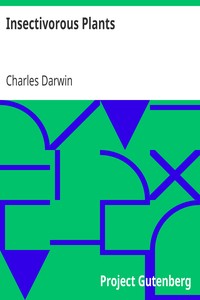Insectivorous Plants by Charles Darwin
"Insectivorous Plants" by Charles Darwin is a scientific publication written in the late 19th century. The book delves into the fascinating biology and anatomy of carnivorous plants, particularly focusing on the mechanisms by which they capture and digest insects. Specifically, it highlights various species, such as the common sundew (Drosera rotundifolia), examining their unique adaptations for survival in nutrient-poor environments. The opening of the book introduces the reader to the common sundew,
illustrating Darwin's observations on how the plant captures an impressive number of insects through its tentacle-like structures filled with viscid secretion. It describes the plant's structure, function, and the intricate process involved in the inflection of its tentacles in response to stimuli from contacting prey. Darwin notes the peculiar sensitivity of the glands responsible for movement and secretion, emphasizing the importance of certain nitrogenous substances in prolonging the inflection and facilitating digestion. The text establishes a methodical exploration of the biological mechanisms underpinning insect capture, setting the stage for detailed examinations in subsequent chapters. (This is an automatically generated summary.)
Read or download for free
| How to read | Url | Size | |||
|---|---|---|---|---|---|
| Read now! | https://www.gutenberg.org/ebooks/5765.html.images | 972 kB | |||
| EPUB3 (E-readers incl. Send-to-Kindle) | https://www.gutenberg.org/ebooks/5765.epub3.images | 399 kB | |||
| EPUB (older E-readers) | https://www.gutenberg.org/ebooks/5765.epub.images | 399 kB | |||
| EPUB (no images, older E-readers) | https://www.gutenberg.org/ebooks/5765.epub.noimages | 388 kB | |||
| Kindle | https://www.gutenberg.org/ebooks/5765.kf8.images | 707 kB | |||
| older Kindles | https://www.gutenberg.org/ebooks/5765.kindle.images | 688 kB | |||
| Plain Text UTF-8 | https://www.gutenberg.org/ebooks/5765.txt.utf-8 | 946 kB | |||
| Download HTML (zip) | https://www.gutenberg.org/cache/epub/5765/pg5765-h.zip | 371 kB | |||
| There may be more files related to this item. | |||||
Similar Books
About this eBook
| Author | Darwin, Charles, 1809-1882 |
|---|---|
| Title | Insectivorous Plants |
| Note | Wikipedia page about this book: https://en.wikipedia.org/wiki/Insectivorous_Plants_(book) |
| Credits | Sue Asscher and David Widger |
| Reading Level | Reading ease score: 58.8 (10th to 12th grade). Somewhat difficult to read. |
| Language | English |
| LoC Class | QK: Science: Botany |
| Subject | Carnivorous plants |
| Subject | Plants -- Assimilation |
| Category | Text |
| EBook-No. | 5765 |
| Release Date | May 1, 2004 |
| Most Recently Updated | Dec 28, 2021 |
| Copyright Status | Public domain in the USA. |
| Downloads | 451 downloads in the last 30 days. |
| Project Gutenberg eBooks are always free! | |

